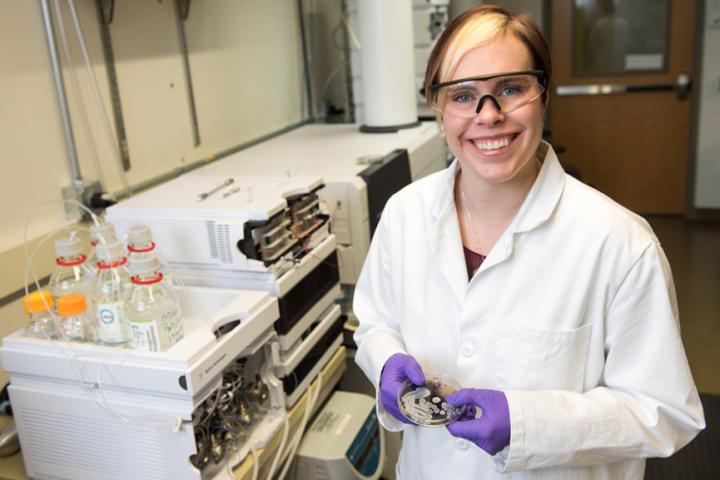First-of-its-kind study shows that non-antibacterial nanoparticles can cause resistance in bacteria

Credit: Patrick O’Leary, University of Minnesota
Over the last two decades, nanotechnology has improved many of the products we use every day from microelectronics to sunscreens. Nanoparticles (particles that are just a few hundred atoms in size) are ending up in the environment by the ton, but scientists are still unclear about the long-term effects of these super-small nanoparticles.
In a first-of-its-kind study, researchers have shown that nanoparticles may have a bigger impact on the environment than previously thought. The research is published in Chemical Science, a peer-reviewed journal of the Royal Society of Chemistry.
Researchers from the National Science Foundation Center for Sustainable Nanotechnology, led by scientists at the University of Minnesota, found that a common, non-disease-causing bacteria found in the environment, called Shewanella oneidensis MR-1, developed rapid resistance when repeatedly exposed to nanoparticles used in making lithium ion batteries, the rechargeable batteries used in portable electronics and electric vehicles. Resistance is when the bacteria can survive at higher and higher quantities of the materials, which means that the fundamental biochemistry and biology of the bacteria is changing.
“At many times throughout history, materials and chemicals like asbestos or DDT have not been tested thoroughly and have caused big problems in our environment,” said Erin Carlson, a University of Minnesota chemistry associate professor in the University’s College of Science and Engineering and the lead author of the study. “We don’t know that these results are that dire, but this study is a warning sign that we need to be careful with all of these new materials, and that they could dramatically change what’s happening in our environment.”
Carlson said the results of this study are unusual because typically when we talk about bacterial resistance it is because we’ve been treating the bacteria with antibiotics. The bacteria become resistant because we are trying to kill them, she said. In this case, the nanoparticles used in lithium ion batteries were never made to kill bacteria.
This is the first report of non-antibacterial nanoparticles causing resistance in bacteria.
In the past, many studies in the field exposed bacteria to a large dose of nanoparticles and observed if the bacteria died. This study was different because it looked at what happens over a more extended period of time to test how the bacteria might adapt over multiple generations when continually exposed to the nanoparticles. The bacteria were clearly able to take higher and higher doses of these materials over time without dying.
“Even though a nanoparticle may not be toxic to a microbe, it can still be dangerous,” said Stephanie Mitchell, a University of Minnesota chemistry graduate student and lead graduate student on this study.
Carlson warns that the results of this study go far beyond just bacteria.
“This research is very important to humans because bacteria are prevalent in our lakes and soil where there is a delicate balance of organisms. Other organisms feed on these microbes and there could be a major effect up the food chain or these resistant bacteria could have other effects we can’t even predict right now.”
Carlson said the researchers will continue follow-up studies to determine the effects of other human-made nanomaterials on other organisms in the environment and the long-term effects.
“Research that both advances technology and sustains our environment is a priority for the Division of Chemistry,” said Michelle Bushey, program director for the Chemical Centers for Innovation Program at the National Science Foundation. “This work reveals unexplored and long-term impacts that some nanoparticles have on the living organisms around us. This discovery at the chemistry-biology interface is a first step toward developing new sustainable materials and practices, as well as providing the groundwork for possible remediation approaches.”
###
In addition to Carlson and Mitchell, other lead researchers on the study include University of Minnesota Chemistry Professor Christy Haynes, Augsburg University Chemistry Associate Professor Z. Vivian Feng, and University of Wisconsin-Madison Chemistry Professor Robert Hamers, the director of the Center for Sustainable Nanotechnology. Others on the research team include University of Minnesota researchers Natalie Hudson-Smith, Meghan Cahill, and Benjamin Reynolds; Augsburg University researchers Seth Frand and Rodrigo Tapia Hernandez; and University of Wisconsin-Madison researchers Curtis Green and Chenyu Wang.
This research was funded by the National Science Foundation through the Center for Sustainable Nanotechnology, an NSF Center for Chemical Innovation.
To read the full research paper, visit the Chemical Science website.
Media Contact
Rhonda Zurn
[email protected]
612-626-7959
Original Source
https:/
Related Journal Article
http://dx.




